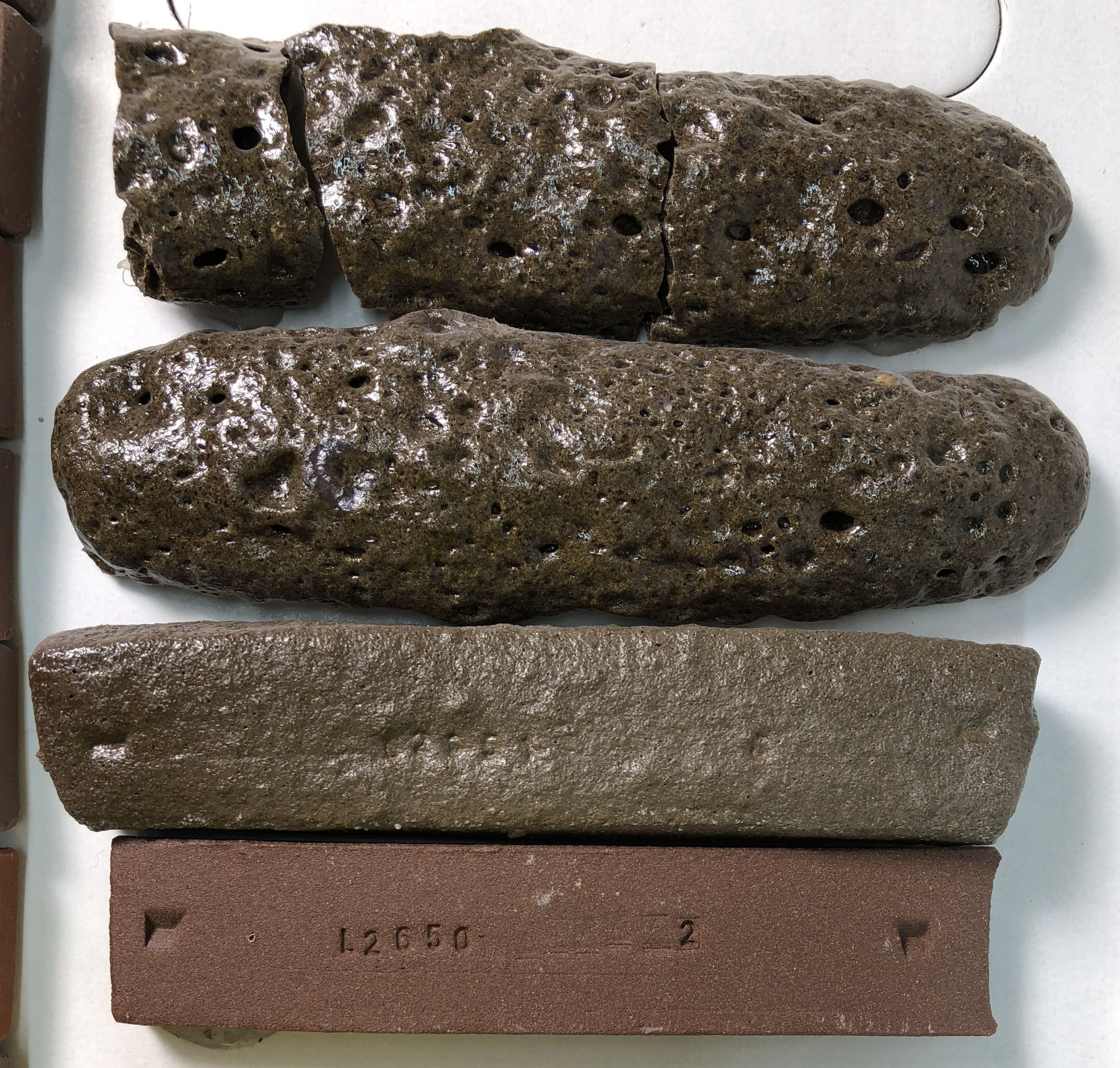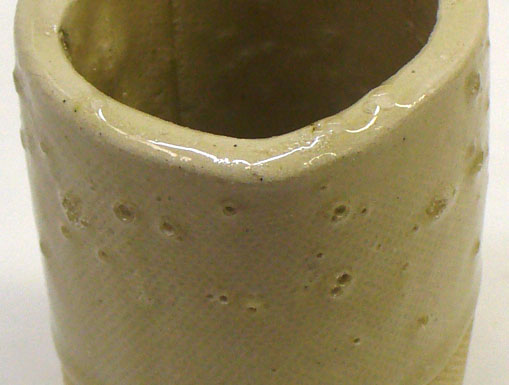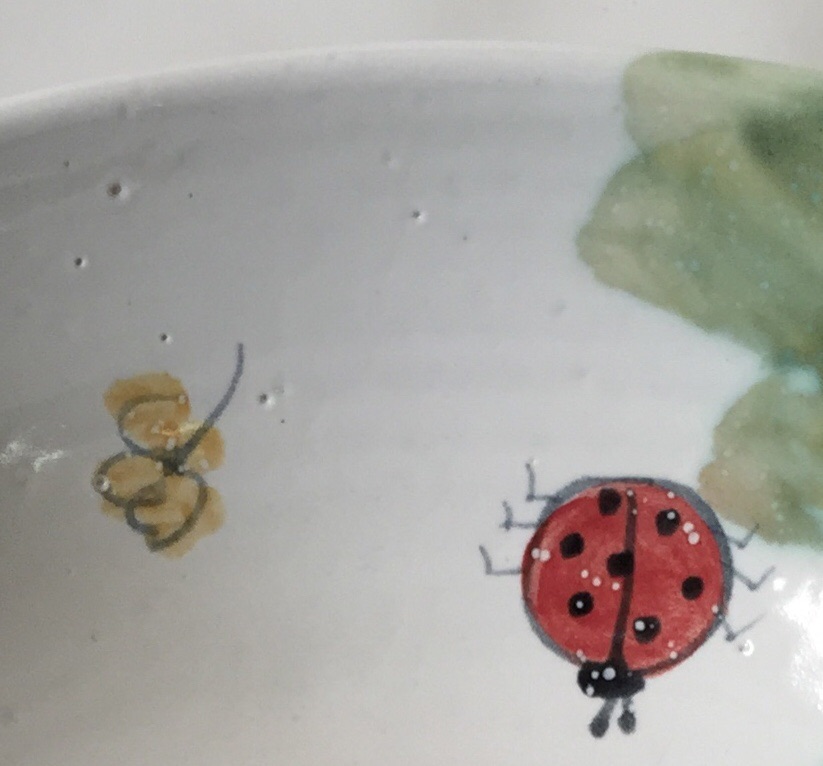| Monthly Tech-Tip | No tracking! No ads! | |
Decomposition
In ceramic manufacture, knowing about the how and when materials decompose during firing is important in production troubleshooting and optimization
Key phrases linking here: decomposition, decomposed, decompose - Learn more
Details
Ceramic kilns are molecule-breaking machines. Mineral powders in a glaze, for example, can find themselves disassembled right down to the oxide level by the time a kiln reaches top temperature (the bonds holding oxides together are broken, weakest first, strongest later). Temperature, interactions and dissolving power of the increasingly fluid melt are the catalysts.

This terra cotta clay melts and expands by cone 6
These plastic terra cotta clay bars are fired, from bottom to top, at cone 2, 6, 8 and 10. As part of the melting process, the gases produced, as carbon-containing materials decompose, produce bubbles. This terra cotta vitrifies to stoneware density at cone 2 (bottom bar), it is even maintaining good red coloration. But by cone 3 it turns brown and by 4 begins to melt and expand. By cone 6 (second from bottom), it has turned into an Aero chocolate bar inside!
As clay bodies mature in a kiln they are partially broken down, some particles like quartz remain unchanged, others like feldspar melt and flow between the quartz and kaolin particle network. But kaolin breaks down differently than quartz and feldspar. For one thing, kaolin crystals are “hydrates”, they have water bonded into their chemical structure, and ordinary drying won't remove it. But the heat generated by the kiln can disconnect that water and enable it to escape as vapour. We call that escaping steam a "product of decomposition". All clays contain this type of water.
Glaze and porcelain materials tend to be refined and homogeneous, particles are generally smaller than 200 mesh and most have the same chemistry and mineralogy. But clay bodies containing minimally processed natural clays, by contrast, not only have much larger particle sizes but those particles can be a who's who of the mineral world! Many of them are high in carbon and sulphur. Each type has a "thermal history" of when it breaks down and what gases it releases (e.g. oxygen, carbon dioxide, carbon monoxide, sulphur dioxide, metal fumes).
For clays that fire stable in color and maturity across a broad temperature range, products of decomposition may be limited to water and carbon, both of which escape early in the firing. But terra cotta clays, for example, are different. The high and diverse population of gas-producing particles, many of which melt at lower temperatures, expels enough gases into overlying glazes to significantly impact the quality and incidence of defects.
Carbon is integral in the crystal structure of some glaze materials (e.g. calcium carbonate, dolomite, barium carbonate). It takes higher temperatures (varying by material) to decompose and liberate CO2 and SO3 from the carbonates and sulphates. Some materials experience decompositions that disqualify them for use in glazes. For example, hydrated lime is a good source of CaO, but 25% of its weight is converted to water at 500C. To say this would be an inconvenient event in a firing would be an understatement!
It is helpful to understand, as background information, what elements, oxides, compounds, solutions and mixtures are.
"Elements" are one kind of atom that cannot be broken down any further (except by nuclear reactions). Atoms have a nucleus with varying numbers of electrons in orbit. Oxygen, silicon, carbon, etc. are among the 100+ elements.
"Compounds" are atoms of more than one element bound together chemically. How? Atoms share electrons or electro-statically attract others having opposite charges. An "oxide" is a compound containing oxygen. A molecule of SiO2 is one atom of silicon and two of oxygen, thus it is an oxide (there are about ten that are important in glazes). Ceramic materials are oxides bonded together. Theoretical soda feldspar, for example, is a compound of oxides: molecules of sodium (Na2O), alumina (Al2O3) and silica (SiO2) are bonded chemically to form a crystalline solid.
"Solutions" are mixtures of molecules in a liquid. In saltwater, for example, the NaCl molecules move independently. But as the water evaporates the mobility of the water enables them to bond in a preferred orientation: crystalline. A glaze melt is a "solution", particles are dissolving into it. Since glaze melts are much more viscous than water solutions, the opportunities for the orientation of particles into crystals during cooling of the melt in the kiln are dramatically less. So they freeze as a "glass", a solid solution.
A bucket of glaze made of feldspar, kaolin and silica powders is a "mixture", the particles are not chemically bonded and they are not dissolved. Rather, they float freely in "suspension" in the water.
Related Information
The perfect storm of high surface tension and high LOI: Blisters.

This picture has its own page with more detail, click here to see it.
An example of how calcium carbonate can cause blistering as it decomposes during firing. This is a cone 6 Ferro Frit 3249 based transparent (G2867) with 15% calcium carbonate added (there is no blistering without it). Calcium carbonate has a very high loss on ignition (LOI) and for this glaze, the gases of its decomposition are coming out at the wrong time. While there likely exists a firing schedule that takes this into account and could mature it to a perfect surface, the glaze is high in MgO, it has a high surface tension. That is likely enabling bubbles to form and hold better.
Calcium carbonate and glaze bubbles

This picture has its own page with more detail, click here to see it.
The two cone 04 glazes on the right have the same chemistry but the center one sources it's CaO from 12% calcium carbonate and ulexite (the other from Gerstley Borate). The glaze on the far left? It is almost bubble free yet it has 27% calcium carbonate. Why? It is fired to cone 6. At lower temperatures carbonates and hydrates (in body and glaze) are more likely to form gas bubbles because that is where they are decomposing (into the oxides that stay around and build the glass and the ones that are escaping as a gas). By cone 6 the bubbles have had lots of time to clear.
Carbonate gassing can cause glaze blisters

This picture has its own page with more detail, click here to see it.
An example of how a carbonate can cause blistering. Carbonates produce gases during decomposition. This glaze (G2415B) contains 10% lithium carbonate, which likely pushes the initial melting temperature down toward the most active decomposition temperatures.
The difference between these low fire transparents: Gerstley Borate vs. Ulexite

This picture has its own page with more detail, click here to see it.
Left: Worthington Clear cone 04 glaze (A) uses Gerstley Borate to supply the B2O3 and CaO. Right: A substitute using Ulexite and 12% calcium carbonate (B). The degree of melting is the same but the gassing of the calcium carbonate has disrupted the flow of B. Gerstley Borate gasses also, but does so at a stage in the firing that does not disrupt this recipe. However, as a glaze, B does not gel and produces a clearer glass. A further adjustment to source CaO from non-gassing wollastonite would likely improve it.
Let me count the reasons this glossy white cone 6 glaze is pinholing

This picture has its own page with more detail, click here to see it.
First, the layer is very thick. Second, the body was only bisque fired to cone 06 and it is a raw brown burning stoneware with lots of coarser particles that generate gases as they are heated. Third, the glaze contains zircopax, it stiffens the melt and makes it less able to heal disruptions in the surface. Fourth, the glaze is high in B2O3, so it starts melting early (around 1450F) and seals the surface so the gases must bubble up through. Fifth, the firing was soaked at the end rather than dropping the temperature a little first (e.g. 100F) and soaking there instead.
White spots and blisters in a high zircon glaze at cone 6

This picture has its own page with more detail, click here to see it.
This is also a common problem at low fire on earthenware clay (but can also appear on a buff stonewares). Those white spots you see on the beetle also cover the entire glaze surface (although not visible). They are sites of gas escaping (from particles decomposing in the body). The spots likely percolate during soaking at top temperate. Some of them, notably on the almost vertical inner walls of this bowl, having not smoothed over during cool down.
What can you do? Use the highest possible bisque temperature, even cone 02 (make the glaze thixotropic so it will hang on to the denser body, see the link below about this). Adjust the glaze chemistry to melt later after gassing has finished (more zinc, less boron). Apply a thinner glaze layer (more thixotropy and lower specific gravity will enable a more even coverage with less thickness). Instead of soaking at temperature, drop 100 degrees and soak there instead (gassing is much less and the increasing viscosity of the melt overcomes the surface tension). Use a body not having any large particles that decompose (and gas) on firing. Use cones to verify the temperature your electronic controller reports.
Ceramic Oxide Periodic Table

Pretty well all common traditional ceramic base glazes are made from less than a dozen elements (plus oxygen). Go to the full picture of this table and click or tap each of the oxides to learn more (on its page at digitalfire.com). When materials melt, they decompose, sourcing these elements in oxide form. The kiln builds the glaze from them, it does not care what material sources what oxide (assuming, of course, that all materials do melt or dissolve completely into the melt to release those oxides). Each of these oxides contributes specific properties to the glass. So, you can look at a formula and make a good prediction of the properties of the fired glaze. And know what specific oxide to increase or decrease to move a property in a given direction (e.g. melting behavior, hardness, durability, thermal expansion, color, gloss, crystallization). And know about how they interact (affecting each other). This is powerful. A lot of ceramic materials are available, hundreds - that is complicated when individual materials source multiple oxides. Viewing a glaze as a simple unity formula of ceramic oxides is just simpler.
Exploding clay. How do you do that?

This picture has its own page with more detail, click here to see it.
The top two terra cotta clay test bars were fired at cone 01 and cone 02. Notice how they puff up inside and eventually split open the outer layer revealing an "Aero chocolate bar" interior. Why? The fine-particled clay at the surface has vitrified and oxidized enough to become an almost porcelain-like surface, sealing it. But terra cotta clays have particulates of many minerals, inside the bars where oxygen is lacking some of them are decomposing and melting (and releasing CO2) at the very same temperature. Guess what happened when I mixed this clay 50:50 with Redart: This effect was gone, it fired to a stable and strong red stoneware. Redart, although also a terra cotta, raises the temperature at which the surface seals, beyond when the gas escape is happening. Some people actually seek this effect. The secret of making it happen is finding a native clay that vitrifies completely at the same temperature as mineral particles are decomposing to create gases.
This terra cotta clay melts and expands by cone 6

This picture has its own page with more detail, click here to see it.
These plastic terra cotta clay bars are fired, from bottom to top, at cone 2, 6, 8 and 10. As part of the melting process, the gases produced, as carbon-containing materials decompose, produce bubbles. This terra cotta vitrifies to stoneware density at cone 2 (bottom bar), it is even maintaining good red coloration. But by cone 3 it turns brown and by 4 begins to melt and expand. By cone 6 (second from bottom), it has turned into an Aero chocolate bar inside!
Links
| Projects |
Temperatures
|
| Tests |
Decomposition Temperature
|
| URLs |
https://digitalfire.com/4sight/temperatures/index.html
Milestone temperatures during firing |
| URLs |
http://www.scielo.br/scielo.php?script=sci_arttext&pid=S0366-69132008000300001
A study of the cmparative decompositions of MgCO3, CaCO3, SrCO3 and BaCO3 |
| Glossary |
Water in Ceramics
Water is the most important ceramic material, it is present every body, glaze or engobe and either the enabler or a participant in almost every ceramic process and phenomena. |
| Glossary |
Water Smoking
In ceramics, this is the period in the kiln firing where the final mechanical water is being removed. The temperature at which this can be done is higher than you might think. |
| Glossary |
Glaze Blisters
Blistering is a common surface defect that occurs with ceramic glazes. The problem emerges from the kiln and can occur erratically in production. And be difficult to solve. |
| Glossary |
Ceramic Oxide
In glaze chemistry, the oxide is the basic unit of formulas and analyses. Knowledge of what materials supply an oxide and of how it affects the fired glass or glaze is a key to control. |
| Glossary |
Glass vs. Crystalline
In ceramics, understanding the difference between what a glass and crystal are provides the basis for understanding the physical presence of glazes and clay bodies. |
| Glossary |
Volatiles
|
| Glossary |
Glaze Chemistry
Glaze chemistry is the study of how the oxide chemistry of glazes relate to the way they fire. It accounts for color, surface, hardness, texture, melting temperature, thermal expansion, etc. |
| Articles |
Where do I start in understanding glazes?
Break your addiction to online recipes that don't work or bottled expensive glazes that you could DIY. Learn why glazes fire as they do. Why each material is used. How to create perfect dipping and brushing properties. Even some chemistry. |
| By Tony Hansen Follow me on        |  |
Got a Question?
Buy me a coffee and we can talk

https://digitalfire.com, All Rights Reserved
Privacy Policy
